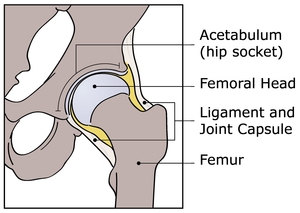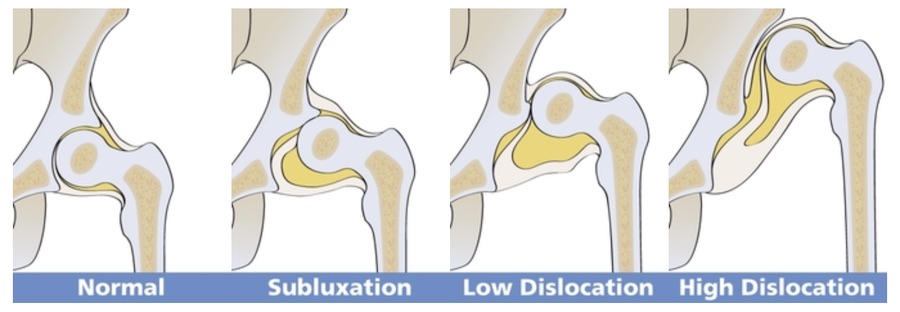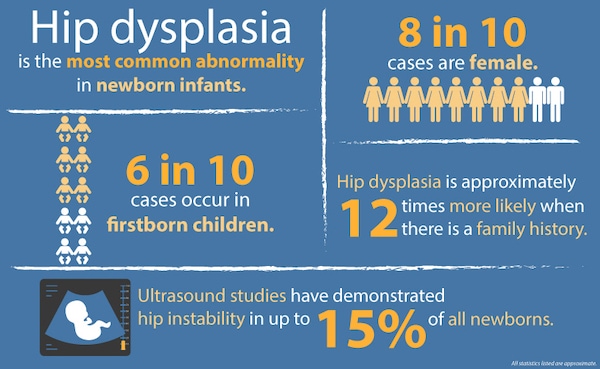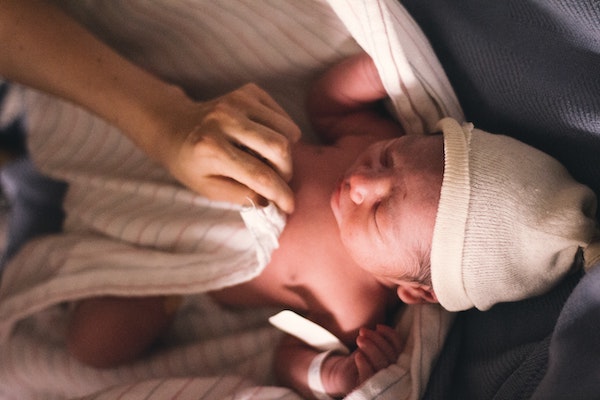Hip dysplasia in newborns and infants is not a condition that most new and experienced parents generally talk or worry about. Reason being, dysplasia of the hip is thought to be an abnormality for adults only.
It might also go unnoticed during infancy and early childhood since it neither causes pain nor prevents the child from learning how to walk at the typical age.
However, the International Hip Dysplasia says that 1 in every 6 babies is born with mild instability of the hip joint that often resolves on its own. But in approximately 2-3 babies in every 1000, this condition requires some sort of intervention including surgery or harnessing.
While these figures seem insignificant, a study that consisted of Norwegian subjects found out that 20% of them required total hip replacement before the age of 40 due to underlying hip dysplasia that wasn’t diagnosed early enough.
So, what causes hip dysplasia? Is your child at the risk of it? What does it mean to have this condition – is it an abnormality?
What Is Hip Dysplasia?

Hip dysplasia refers to a problem of the hip joint whereby the socket on the pelvis bone does not have enough curvature to fit the entire head of the upper thighbone. As such the thighbone tends to be either partially or completely dislocated.
In a normal hip joint (shown in picture above), the head of the femur (thigh bone) fits snugly in the acetabulum (socket of the pelvis bone).
In a dysplastic hip bone, the socket of the pelvic bone may not be deep enough to accommodate the femoral head as it’s supposed to. Therefore, the ball is not stable within the socket and this makes it slide in and out and may also dislodge either partially or completely (see the picture below).

Besides a malformation of the cup-shaped socket of the pelvis, a dysplastic hip bone may be as a result of loose tissues around the joint thereby causing the femoral head to slide out.
Developmental Dysplasia Of The Hip In Infants And Babies
Although hip dysplasia is commonly thought to be an adults’ problem, experts say that it is a congenital health problem that an infant is born with.
It may also develop during the baby’s first year after birth. This is why is it is also commonly known as the Developmental Dysplasia of the Hip (DDH).
Is your child at risk?

Risk Factors Of Developmental Dysplasia Of The Hip
The exact cause of DDH is not known so far. But orthopedists speculate that it is largely developmental. Several events have been found to increase the odds that a baby will have DDH.
Family History
In a study analyzing the association between different risk factors and developmental dysplasia of the hip, the researchers state that an infant has a 12-times higher risk of having DDH if he/she has a first-degree relative (mother or father) who suffered DDH during childhood. This is an indication that DDH can be genetically inherited from the parents to the child.
On the same note, researchers in the study above also found out that infants with second-degree relatives (aunts, uncles, nephews, and nieces, etc) have a 2.5-3.5-times higher risk of having DDH.
Another important finding here was that an infant with a relative who has DDH has a slightly higher risk of having an unsuccessful brace treatment (more about this treatment later).
Breech Position
Breech presentation has also been found to carry a considerably higher risk (2.5 times) of Developmental Dysplasia of the Hip.
Breech presentation in pregnancy occurs when the baby fails to move into delivery position (head towards the birth canal) during the last weeks leading to delivery. In such a situation, the buttocks (and/or the legs) are at the bottom ready to be delivered first.
There are several schools of thoughts on how the breech position causes DDH. First, experts say that the baby’s movement is highly restricted in this position. In prolonged periods, this could cause the hip joint to misalign (subluxate) or dislocate altogether.
The second argument is that in the breech position more so when the feet are extended toward the birth canal (frank breech), the hamstrings are overly stretched. This could pull the femoral head out of the socket thereby leading to DDH.
Oligohydramnios (Low Amniotic Fluid)
Affecting the baby in the womb in a similar manner to the breech presentation is the oligohydramnios – a situation where there is not enough fluid surrounding the baby while in the womb.
This is a serious condition that is associated with several effects including hip dysplasia in newborns. Just like in the breech position, the baby does not move as easily as it should when there is low amniotic fluid. This could increase the pressure around the hips leading to a problem on the development of the hip joint.
Infant’s Response To Birth Hormones (Relaxin)
Relaxin is a hormone with an important role during pregnancy: as its name suggests, this hormone relaxes cervix muscles as well as the ligaments of the pelvis in preparation for the baby’s passage through the birth canal.
Unfortunately, these hormones can affect the baby too and may cause the ligaments of their pelvis even softer thereby increasing the odds of hip dysplasia.
Girls Are More Prone To DDH Than Boys
Importantly, girls are more prone to the effects of relaxin than boys. This is because in the latter, the hormone androgen cushions the infant from the effects of relaxin to some degree.
Although boys and girls have androgen, boys have a much higher level of it. This partly explains why girls have a 4 to 8-time higher risk of suffering from developmental hip dysplasia than boys.
Firstborns
Being the firstborn has also been found to be a predisposing factor for DDH. This is because the uterus is tight and, therefore, limits the movement of the baby.
More details about the studies on risk factors (like breech presentation, oligohydramnios, female sex and primiparity) you can find in this article.
Swaddling And Hip Dysplasia – What’s The Connection?
Every mom has heard of the benefits of swaddling to newborns. But it might come as a surprise that this art of wrapping up a baby snuggly for security and comfort also increases the risks of DDH if it’s not done correctly.

In his work, Swaddling and Hip Dysplasia, Professor Nicholas Clarke, Consultant Orthopedic Surgeon at the University of Southampton says that traditional swaddling puts prolonged pressure on the extended hip thereby predisposing the baby to dysplasia.
On this note, he cites a study done in Norway and that consisted of 713 young adults who had had a total replacement of the hip due to dysplasia. Of these participants, the researchers noted that 88% had been swaddled. This points out a strong correlation between swaddling and hip dysplasia.
In the 1950s, high incidences of hip dysplasia were reported among Navajo Indians where cradleboard swaddling was common. Later, this prevalence decreased significantly after swaddling clothes were introduced.
Prof. Nicholas concludes that midwives, pediatricians, and neonatologists should offer advice on proper ways of healthy swaddling practices that promote early hip development.
The American Academy of Pediatrics says that the prevention of DDH begins with ensuring that the baby is put at a flexed and abducted hip position right after birth.
Note that the AAP does not deny the benefits of swaddling. However, it recommends hip-healthy styles that promote slight flexion and abduction of the hip and knees.
Here is a video by the International Hip Dysplasia Institute (IHDI) on how to swaddle the baby safely.
Babywearing And The Risk Of DDH
The IHDI notes that there is no direct link between babywearing and hip dysplasia. However, it recommends babywearing techniques that promote healthy hip development.
In particular, the IHDI discourages carriers that don’t support the thigh up to the knee. Experts say that the resulting pressure from this position predisposes the baby to hip dysplasia.
When using a carrier or a sling, the IHDI recommends ensuring that the thigh is supported to the knee. This ensures that the baby is held in what is commonly known as the Spread Squat, froggy, or Ergonomic M-position that exerts minimal pressure on the hip joint.
More about baby wearing safety and proper positioning the baby in my article.

Diagnosing Developmental Dysplasia Of The Hip
While conditions such as oligohydramnios (low amniotic fluid) and breech position increase the risk of hip dislocation during gestation, there’s no gold standard for diagnosing this hip problem prenatally.
But the good news is that it can be detected as soon as the baby has been born during the newborn physical examination. Further checks are also done at subsequent hospital visits particularly 6 and 8 weeks to diagnose DDH early.
If the signs of DDH are picked up early enough, precisely during the first 6 months, most babies have been found to respond very well to treatment.
In case DDH is not diagnosed early, the baby has a very high risk of developing osteoarthritis during their childhood.
How DDH Is Diagnosed At The Hospital
Physical examination after birth and during infancy is the most common and effective method of early DDH detection. This exam consists of 2 tests that confirm each other’s results:
- Ortolani test – this test involves using an upward force to move the supine child’s hip away from the body. This movement is called abduction. DDH is positive if there’s a distinctive clunk sound.
- Barlow maneuver – in this test, the examiner uses downward force to bring the thigh towards the midline. The results are considered positive if the hip pops out of the socket.
Besides taking your child for regular checkups more so if there’s a history of DDH in your family, there are several known signs that could help pick up DDH in your baby.
Signs to look for:
- Limited leg movement when changing diapers
- Uneven skin creases on the thigh or buttocks
- An abnormally wider space between the legs
- The leg on the dislocated side (mostly left) may appear shorter
- Pain – babies with DDH don’t experience any form of pain during their infancy. However, if it goes undetected or untreated, there may be notable pain during adolescence and young adulthood
Treatment Of Developmental Dysplasia Of The Hip
Early diagnosis of DDH is crucial for an effective treatment. The American Academy of Orthopedic Surgeons states that if diagnosed and successful treated early enough, children have a chance to develop a normal and fully functional hip joint.
In case your healthcare provider detects any DDH red flags during your baby’s first month of life, he/she is probably going to give the conditions more time to see whether it will correct itself as the baby’s soft hip joint cartilage hardens. If the condition persists by week 4 or 6, you may be referred to an orthopedic surgeon.
Treatment can either be nonsurgical or surgical depending on the age, symptoms and general health of the baby.
Newborns
The most common type of treatment for newborns is the use of a popular device known as a Pavlik harness. This is a special brace that holds the hip in the proper position that is required for correction while allowing free leg movement and diaper change.
1-6 months
If DDH is diagnosed at 1 to 6 months, a similar harness to the Pavlik may be used. This harness is worn full-time for around 6 weeks followed by another 6 weeks of part-time wearing. It is known to work successfully even when the hip was initially dislocated.
In case DDH is still present by the 6th month, your doctor may have to do a closed reduction procedure. This method involves putting the baby under anesthesia and then using a spica cast to hold her thighbone in the proper position.
6 months to 2 years
Kids within this age bracket are also treated using a spica test. But keep in mind that DDH gets severe as the child gets more active. Therefore, this nonsurgical procedure may not always be successful for these kids.
If DDH is still present, the next best option is to have open surgery. This procedure involves incising the affected hip to assess the hip joint. After treatment, the child will be put in a spica cast to promote proper hip positioning.
Can You Prevent DDH In Babies?
Unfortunately, there’s no way to prevent hip dysplasia in babies. This is because, as we said before, dysplasia is both hereditary and it can also develop either during pregnancy and even a year after birth.
However, there are things that you can do to lower the risk of DDH including:
- Seek emergency medical attention in case you detect low amniotic fluid during pregnancy
- Have regular checkups with your pediatrician especially during the first 6 months to ensure early diagnosis in case your baby is affected
- Avoid tight swaddling
- Always ensure to babywear the baby in the M position. This boils down to getting the best baby carriers and slings that are designed in an ergonomic way. List of hip-healthy baby carriers made by the International Hip Dysplasia Institute may be helpful for baby wearing beginners. I also encourage you to check my list of safest & most comfortable carriers for newborns which includes only the carriers recognized by the IHDI as safe for baby’s hips.
Bibliography:
Chan, Annabelle, et al. “Perinatal risk factors for developmental dysplasia of the hip.” Archives of Disease in Childhood-Fetal and Neonatal Edition 76.2 (1997): F94-F100.
Clarke, N. M. P. “Swaddling and hip dysplasia: an orthopaedic perspective.” (2014): 5-6.
Engesæter, Ingvild Ø., et al. “Total hip replacement in young adults with hip dysplasia: age at diagnosis, previous treatment, quality of life, and validation of diagnoses reported to the Norwegian Arthroplasty Register between 1987 and 2007.” Acta orthopaedica 82.2 (2011): 149-154.
Ömeroğlu, H et al. “Associations between risk factors and developmental dysplasia of the hip and ultrasonographic hip type: a retrospective case control study.” Journal of children’s orthopaedics 13.2 (2019): 161-166.
Price, Charles T., and Richard M. Schwend. “Improper swaddling a risk factor for developmental dysplasia of hip.” American Academy of Pediatrics News 32.11 (2011).
Please keep in mind that this article IS NOT a medical advice. The purpose of this article is informative. It’s not a substitute for consultation with a doctor. Always consult your health concerns and decisions with your doctor.

